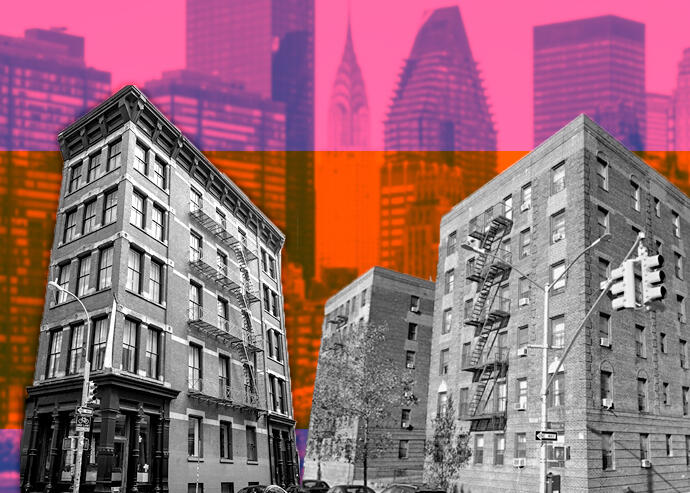
1491 Watson Avenue, Bronx (iStock and Google Maps)
When the 2019 rent law passed, the real estate industry warned of a housing apocalypse — small owners, unable to raise rents enough to maintain their properties, forced into distressed sales with faceless investors.
The pandemic then tacked on higher expenses and non-paying, eviction-proof tenants.
Multifamily sales figures for the past two years show a growing number of mid-sized landlords chose to unload their properties in a down market — possibly because they could no longer afford them.
Rosedale Management, a family-operated owner and manager of New York City rentals for three generations, has sold 10 of its 13 properties in the past year and a half.
It listed four properties as soon as the rent law passed. Two, in the Bronx, needed new elevators — a $600,000 job. Under the old law, Rosedale could have passed the cost along to tenants through a 6 percent rent hike. But the reform capped rent raises for major capital improvements at 2 percent for buildings where at least 35 percent of units were rent-stabilized.
Unable to raise rents enough to finance the repairs, Rosedale sold. One property, 1491 Watson Avenue in Soundview, fetched $7.1 million — $700,00 less than what Rosedale had paid in 2012.
“That was solely due to the changes in the rent laws,” a spokesperson for the firm said. “There was absolutely no way to break even.”
Rosedale unloaded three more buildings in early 2020 and a fourth in October.
The pandemic further squeezed the landlord. The Rent Guidelines Board in June 2020 froze rents on regulated units for a year. Meanwhile, the cost of insurance, repairs and property taxes had risen, and more tenants weren’t paying the rent.
With income not keeping up with expenses, Rosedale took a critical look at its remaining buildings — and sold five more. Four multifamily properties went for a total of $66.7 million and a commercial storefront at 57-23 Myrtle Avenue in Ridgewood fetched $4.9 million. Rosedale expects to close on a sixth sale, at 135 West 255th Street in Marble Hill, this month.
“When we looked at the rent laws, the expenses and the income stream, it didn’t make sense to continue ownership,” Rosedale’s spokesperson said.
That leaves the company with three buildings. Two have sentimental value to the firm: Its owner’s father built one, in Queens, in 1960, and it has owned the other since 1949. The third, purchased in a 1990 foreclosure sale, has rent-controlled tenants whose bargain rates will end when they leave, unlike with rent-stabilized units.
Still, the firm expects it will have to sell those eventually. Even after shedding 275 units in the past year, Rosedale said it is paying more for insurance. Property taxes are higher, as are utility bills. “It just becomes insurmountable,” the spokesperson said.
Rosedale isn’t alone. Multifamily building sales from 2017 through the second quarter of 2021 show new listings for properties in Brooklyn jumped as much as 167 percent in a quarter since the law changed and signed contracts by up to 285 percent, according to data from UrbanDigs.
In Manhattan, the highest increases were 90 percent for listings and 88 percent for contracts — substantial, but lower. The reason may be that Brooklyn is populated primarily by landlords with mid-sized portfolios — 30 or fewer buildings — a JustFix analysis shows. Manhattan multifamily buildings are almost entirely owned by landlords with 30 to 60 properties, and no other borough has more than 60 under one owner.
While smaller owners struggle to swallow higher costs, bigger investors with diversified portfolios and better backing are more equipped to handle the expense.
Prana, a San Francisco-based investment firm, has snapped up at least 17 properties in the past four years, according to a record of deals compiled by The Real Deal. It has bought half of Rosedale’s buildings.
Landlord groups believe the true impact of the past two years will be revealed when the state’s foreclosure moratorium expires Aug. 31. Some are waiting to see if federal rental assistance — none of which New York has distributed yet — can buy them another year. Others are hoping they can sell when the market turns around.
In Manhattan, the median asking sale price for multifamily rental buildings dropped 76 percent from $7.6 million in the quarter before the rent law passed to $2.1 million in the quarter after. It only started to recover in the second quarter of this year, rising to $4.6 million. But no one is celebrating.
“I don’t think we can accurately predict what happens next until we know the scale of the problem and see what the government is willing to do to help housing providers,” said Jay Martin, the executive director of landlord group Community Housing Improvement Program.



